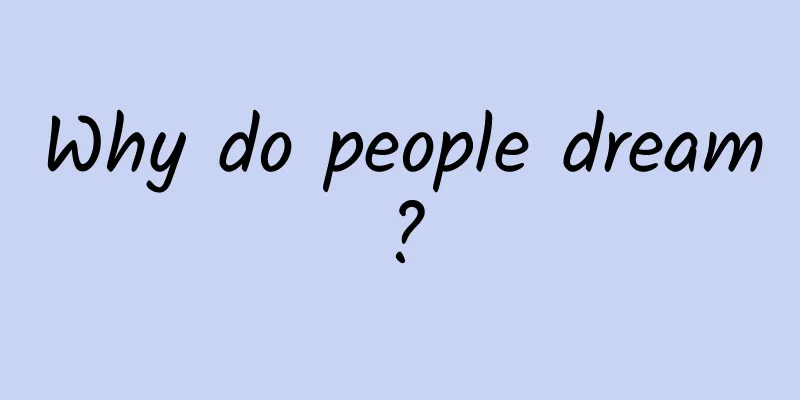Why do people dream?

|
Dreaming is one of the most wonderful experiences of human beings. Throughout the ages, countless people have wanted to explore the mysteries of dreams. From divination to predicting good and bad luck, people have always believed that dreams have a wonderful connection with reality. So the question is, why do people dream? In 1899, Austrian psychologist Sigmund Freud's "The Interpretation of Dreams" opened up a new field for dream research: psychology. He believed that dreams are an expression of human desires in real life. In dreams, people can do things that are impossible in real life. Through dreaming, people discover their inner desires and release their inner pressure. Although Freud's theory has gained support from many people, there is another group of people who believe that dreams have no objective meaning. In 1977, two psychiatrists at Harvard University, John Alan Haberson and Robert McCully, proposed a theory that the content of dreams has no meaning and is just a side effect of unconscious activity in the synapses of the brainstem during sleep. In recent years, scientists have conducted more in-depth research on dreams, and they have found that the mechanism of dreaming may be more complicated than previously imagined. We know that people have two stages of sleep: rapid eye movement (REM) sleep and non-rapid eye movement (NREM) sleep. During the REM sleep stage, brain neuron activity is very active, while during the NREM sleep stage, the brain activity is very low. But the amazing thing is that people will dream in these two sleep stages, and the probability is not very different. Does dreaming have nothing to do with the activity of the brain? With the advent of high-density EEG technology, the number of electrodes on the EEG cap has increased to 256, allowing scientists to study in more detail the activity of different brain regions when people are dreaming. They found that at the same time, the sleep conditions of different brain regions are not consistent, just like dolphins can alternate between the left and right brains to fall asleep, and the human brain can also rest in different regions. Since 2013, in order to obtain more accurate data, neurologist and sleep medicine expert Francesca Siclari has collaborated with the Wisconsin Sleep and Consciousness Research Center at the University of Wisconsin-Madison to invite voluntary subjects to wear EEG caps and spend the night in the laboratory. During the nearly five years of the experiment, they conducted nearly a thousand awakening processes on the voluntary subjects and recorded hundreds of dream information. The data show that when people dream, the high-frequency activity of the "posterior cortical hot zone" in the brain increases. This area includes the visual area, precuneus, posterior cingulate gyrus, etc., which can integrate different senses together, so even in fictional dreams, we can still see images and hear sounds. The study also showed that in order to generate consciousness during sleep, it is not necessary to activate the entire cerebral cortex, but only a relatively narrow area, the posterior cortical hot zone, which explains why people can dream during both REM and NREM sleep. In 2017, Siklari wrote a paper on the results of his study and published it in journals such as Nature Neuroscience and Current Opinion in Neurobiology, which contributed to the continued study of dreams by future generations. Although scientists are still unable to figure out the specific mechanism of human dreaming, it is possible to decipher and reconstruct dreams. Perhaps in the near future, we will be able to glimpse the mystery of dreams. This article is a work supported by Science Popularization China Starry Sky Project Team Name: The Nutcracker Review: Tao Ning Produced by: China Association for Science and Technology Department of Science Popularization Producer: China Science and Technology Press Co., Ltd., Beijing Zhongke Xinghe Culture Media Co., Ltd. |
>>: Why do fireflies flash synchronously?
Recommend
The dual face of vivo: conservative in mobile phones, radical in Internet finance
In November 2011, three months after the release ...
How to pour the perfect beer while watching a game?
Author: Li Cunpu, Associate Professor, College of...
Foods containing aluminum: I won’t take the blame for Alzheimer’s disease!
Will eating foods containing aluminum cause Alzhe...
It will really make you laugh so hard! Doctors remind you to be careful with these actions
Recently, on a variety show, a male star dislocat...
Why did Steve Jobs forbid his children from using iPads at home?
Although Apple invented the iPad, as one of the im...
How do we “see” the brightest “fireworks” in the universe?
On October 9, 2022, there was a very shocking and...
Scientists unveil Ebola virus's 'replication machine'
In September this year, the Ebola outbreak reappe...
Your app has no users mainly because of the following reasons...
[[144037]] Recently, I have been in contact with ...
How to effectively and accurately reach users with activities
In fact, in the user-operated activity-based mark...
China Passenger Car Association: Wuling Hongguang MINI EV sold 41,255 units in October 2022, a year-on-year decrease of 13.8%
The China Passenger Car Association released the ...
The author personally interprets: How important is the “cloud” seen by China’s Sky Eye?
In October this year, the National Astronomical O...
The forms and methods of Zhihu promotion
Zhihu’s advertising formats are diverse, includin...
Want to go diving in Sanya? Don’t touch these “punishing” corals
With the relaxation of epidemic prevention polici...
Looking at the decline of Japan's television industry, can China become the next South Korea?
China has always had an awkward position in the g...
Google announces official release of Android 8.1 in December, Android 8.0 adapter manufacturers need to speed up
Recently, when many Android phone manufacturers h...









